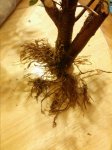Your tree appears to be a Siberian elm, Ulmus pumila, which is sometimes used for bonsai training. Although Chinese elm is far superior, Siberian elm is a good tree to begin with. Siberian elms quickly develop, are easy to train but fine twigs tend to die during the winter. It's a bit discouraging to develop a Siberian elm for five to ten years, develop fine twig ramification, then have to begin twig development all over again. But remember the trunk and major branching will already have a good form so they can quickly be developed again, and again and again…
Chinese elm have a different color and bark texture. Also Chinese elm have a dark green shorter leaf than Siberian elm which is more winter hardy than Chinese elm. Siberian elms are often mass planted for hedging and are faster growing than Chinese elm. Basically, its a cheap tree mass produced for quick sales. But, I've seen some spectacular bonsai developed from Siberian elm which need twig development yearly.
I suggest you dig the tree when the buds begin to show green, not before, especially in your climate. If you do this too early the tree will just "sit" there until the correct time for leafing out. On the other hand if you dig when the buds are green, even with a few opening leaves, the tree will just continue to grow like nothing has been done with it.
Before digging, remove the branches and trunks you want with rough cuts. This will make digging easier. And, be sure to severely cut the heavy roots, probably remove them completely. Don't worry about survival. Siberian elm can survive with only a few fine fibrous roots around the trunk, especially when drastically pruning. During the past 50 years I've discovered its much better to do ALL the drastic pruning ONCE, not spread over time. This includes the roots as well. The traree will only be shocked once and only need to recover once. So, this is your beset opportunity to develop a basic form and have the tree recover quickly.
After digging, take your garden hose and using a strong jet of water, remove ALL the soil. This might sound drastic, and may take some effort but it will be worthwhile in the long term development of your bonsai. By removing all of the original field soil it will stimulate fine fibrous root development, especially if you use a coarse soil mix. And, while you are at it, thoroughly wash all of the bark which will remove a lot of old bark and dirt from the trunk and branches to allow the dormant buds to easily develop since they do not need to push through the old stuff. All of my deciduous bonsai, and I have many, are washed yearly.
Be certain to cover all cuts, larger than your thumb, with a tree wound sealant. If you don't have cut paste, use Elmers glue, not the black tree wound sealant commonly sold at garden centers. I can show you a Trident maple drastically pruned over 30 years ago which still has small trees of the black tar tree wound sealant, cut paste did not exist way back then.
Pot the tree in some kind of container, smaller than larger, using a coarse soil, not fine to develop branching easier. Then, after potting, after YOU have recovered from digging you can take your time to make the final cuts. But remember to remove as many large thick branches as possible, don't keep them as they will continue to thicken and will make the trunk appear thinner. Keeping the thinner branches will make the trunk looked thicker and will be easier to shape. They will quickly thicken.
After potting keep the tree in FULL sun immediately and water often, but out of strong wind. Feed with a high nitrogen liquid fertilizer, like 20-20-20 from spring to early autumn once a week. This will quirky help your tree produce new shoots. Don't keep your tree in the shade.
Good luck with your project and try to walk around the tree in the ground many times mentally looking and thinking of the elimination of trunks and branching. But, most important, have fun. It will be quite a bit of work to dig the tree, make it easier for you and use a sawsall, but Siberian elm can easily recover from drastic pruning and develop into a great bonsai form. Keeping the great bonsai form with twigs is another future topic. Hope this helps.
Bill








